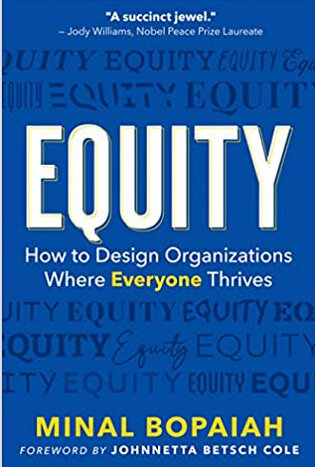Equity: How to Design Organizations Where Everyone Thrives
Brevity and Wit, author Minal Bopaiah's strategy and design firm, could also be a good description of the way in which Bopaiah addresses the complicated concepts in her book, Equity: How to Design Organizations Where Everyone Thrives. In six short chapters (along with an introduction and conclusion), Bopaiah both educates readers in equity-related concepts and equips leaders with tools they can use in their organizations' efforts to "design for equity."
Bopaiah first explains how the concept of "equity" differs from that of "equality," defines each term in IDEA (Inclusion, Diversity, Equity, and Accessibility), and explores how equity drives inclusion. She then illustrates the three preconditions necessary before an organization can begin to move toward a full expression of equity:
1) Differences between individuals and groups are valued, not demonized or minimized;
2) People with power can see systems and how they influence opportunities for others; and
3) People with power want to create more opportunity so everyone can thrive with their differences intact.
Once she has provided context for those preconditions — how implicit bias shapes how we design systems and organizations — and discussed each of the issues, Bopaiah provides the reader with tools to evaluate their organizations' current status. She then details how to redesign an organization to create and support equitable outcomes, how to communicate IDEA and reduce resistance internally, and how to embed IDEA into external marketing and communications.
As Bopaiah herself notes, attempting to convey such "heady topics in a friendly manner" in a slim volume of 160 pages is a challenge. But she succeeds in making all of her points clear in three vital ways:
As Bopaiah herself notes, attempting to convey such "heady topics in a friendly manner" in a slim volume of 160 pages is a challenge. But she succeeds in making all of her points clear....
First, she builds each chapter around established, effective procedures, using materials already created by Brevity and Wit (such as their work on communicating equitable change with the Horizon Foundation in Howard County, Maryland) along with the work of experts in the field who've put together the best examples of how to advance equity. The collaborative integration of concepts between and within Bopaiah's work and the equity work of the Robert Wood Johnson Foundation, the Human-Centered Design work of Stanford and other research institutes, and the REACH equity work of Vu Le, among many others, means that readers can link concepts they may already know with the use of those concepts in the organizational work Bopaiah describes. While providing links to websites and further illustrations of complex concepts, she also selects the most salient information from these experts to make her points.
This intersectionality alone could make the entire book too much of a weighty accumulation of established data. As a second method of clarifying her points, she uses anecdotes from a wide spectrum of sources — including her own family. Her work with the Sesame Workshop, NPR, and Evans Consulting provide real-life examples and give human faces to the struggles that individuals seeking true equity, however well-meaning, go through. The experience of her husband, a firefighter, with fire captains at a diversity and inclusion conference provides one of the most amusing and incisive lessons in the importance of making IDEA concepts relatable. "[A]re we implying in our conversations and reading lists that everyone needs a doctorate in social justice just to be inclusive and equitable?" she asks. Her illuminating discussion of the difference between "race" as language and "caste" as grammar, drawn from Isabel Wilkerson's book Caste: The Origins of Our Discontents, allows her to use several stories to underline the vital idea that "words matter immensely because they bring visibility and respect to marginalized people. But on a deeper level, the structure of your sentences, which reflect the structure of your thoughts, matters more." This knotty issue is made crystal clear with simple phrasing — and with humor: "This does not mean you should abandon all efforts to get word choice right. I am giving you permission to abandon perfection for earnest effort. I am not giving you permission to half-ass this."
From anecdotes like her husband's firefighter conference, the story of the development of the Embrace infant warmer, actress Anne Hathaway's story of her own privilege, and the failure of Stockholm's Piano Stairs as a nudge toward IDEA, the equity concepts and tools come alive in a vivid way. But thirdly, and perhaps most importantly, she ensures that the book is directly relatable by recounting her personal experiences of being caught in the systemic inequity of America. The first story she tells in the book — of how her parents and the free education they received in India allowed them to come to America and get jobs immediately — reveals the systemic inequities of the U.S. immigration system and how it uses socialized education in other countries to meet labor needs. Later in the book, she uses Fifth Domain Coaching's Group Identity Wheel to look directly at how she is in some ways part of historically marginalized groups (South Asian/Brown, Hindu/Buddhist, Kodava/Coorg/Punjabi/Sikh/Native New Yorker) and in other ways part of historically centered groups (upper middle class, highly educated, straight, able-bodied). Bopaiah's willingness to use herself as an example encourages readers to do the same, and by the end of the book, when she turns a hard eye on America's equation of capitalism and democracy and the ways in which the nonprofit sector is "neither automatically democratic nor equitable" readers may belatedly realize how much more they are caught up the system and its inequities than they had thought.
Though this book is short, it's dense; it's meant to be studied, dog-eared, and shared throughout your organization. Just the glossary alone, with a three-page list of the most crucial concepts addressed in the book, will be enough to keep readers going back to this book regularly as a reference guide. Those looking for a way into the immense change that seeking equity requires would do well to look at this book as an elegantly written skeleton key.
David M. Holmes is Programs Manager, Midwest, at Candid.








